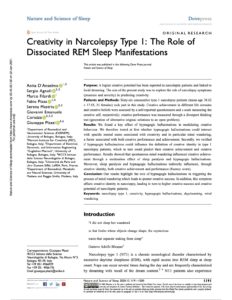 Creativity in Narcolepsy Type 1: The Role of Dissociated REM Sleep Manifestations
Creativity in Narcolepsy Type 1: The Role of Dissociated REM Sleep Manifestations
Purpose: A higher creative potential has been reported in narcoleptic patients and linked to lucid dreaming. The aim of the present study was to explore the role of narcolepsy symptoms (presence and severity) in predicting creativity.
Patients and Methods: Sixty-six consecutive type 1 narcolepsy patients (mean age 38.62 ± 17.05, 31 females) took part in this study. Creative achievement in different life domains and creative beliefs were assessed by a self-reported questionnaire and a scale measuring the creative self, respectively; creative performance was measured through a divergent thinking test (generation of alternative original solutions to an open problem).
Results: We found a key effect of hypnagogic hallucinations in modulating creative behaviour. We therefore tested at first whether hypnagogic hallucinations could interact with specific mental states associated with creativity and in particular mind wandering, a factor associated with both creative performance and achievement. Secondly, we verified if hypnagogic hallucinations could influence the definition of creative identity in type 1 narcolepsy patients, which in turn could predict their creative achievement and creative performance. Results showed that spontaneous mind wandering influenced creative achievement through a moderation effect of sleep paralysis and hypnagogic hallucinations. Moreover, sleep paralysis and hypnagogic hallucinations indirectly influenced, through creative identity, both creative achievement and performance (fluency score).
Conclusion: Our results highlight the role of hypnagogic hallucinations in triggering the process of mind wandering which leads to greater creative success. In addition, this symptom affects creative identity in narcolepsy, leading in turn to higher creative success and creative potential of narcoleptic patients.
Download the paper at: https://www.dovepress.com/creativity-in-narcolepsy-type-1-the-role-of-dissociated-rem-sleep-mani-peer-reviewed-fulltext-article-NSS#
